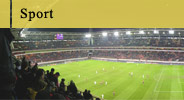Veteran GAA broadcaster and author Seán Óg Ó Ceallacháin speaks to Stephen Mangan about his long and storied career in Gaelic Games, both on and off the hallowed turf
Since Seán Óg O Ceallacháin began his vocation within GAA circles, one feature of the association has always stayed the same. In the 1940s, despite food rations and the country’s first brush with foot-and-mouth disease, the GAA were in a reasonably sound financial position.
Today, in the age of marketing and media, finances are soaring as the association moves away from the more intolerant attitudes of the past. Through his positions as a player, referee, journalist and broadcaster, Seán Óg has witnessed it all.
When he started playing hurling with his young pals in Fairview, the organisation supported the objective of Irish independence, and its packed grounds were a forum for republicanism. As Seán Óg was making his hurling debut for his club, Eoghan Ruadhs, Nazi Germany was waging war against the Allied forces.
Later, when the first All-Ireland finals were televised by a newly established national broadcaster called RTE, Seán Óg was chosen to commentate. And when the legendary boxer Muhammad Ali travelled to London for a title bout against Henry Cooper, Seán Óg was trusted by RTE chiefs to get an interview with the ‘Greatest of All Time’.
At 84 years of age, Seán Óg has lived a truly astonishing and productive life that shows no signs of stopping. In late 2006 he added his latest book, The Dubs, to his tally of published works. It details Dublin GAA through the years of World War II, the era of Kevin Heffernan’s management and the subsequent decline since ‘Heffo’ and his team of stars waved goodbye to Hill 16.
The book demonstrates its author’s ability to precisely recollect events and provides the launch pad for an excellent reflection on how the fortunes of Gaelic Games in the capital have changed through history.
Seán Óg is Europe’s longest serving broadcaster and a true Dublin legend. His Gaelic Sports Results programme – cited as the longest running radio programme in the world – has gone out every Sunday night since his late father launched the series in the 1930s, and has since developed a worldwide audience among the Irish diaspora through satellite and web broadcasting.
A footballer and hurler with Dublin, Seán Óg was – as the interview with Muhammad Ali would suggest – a journalist at the top of the game. But his expertise lies in Gaelic Games, and the Limerick native was a renowned GAA sports writer with the Evening Press until its closure in the mid-1990s.
While many of his cotemporaries would settle for a relaxing retirement, Seán Óg has no plans to follow suit. Age hasn’t stifled his appetite for work, and he recently finished his ninth book, The Greats of Gaelic Football, which is due for release later this year.
“I won’t be retiring until someone puts a gun to my head and tells me to do it,” he says. “RTE are quite happy with what I’m doing at the moment and I’m happy to keep working because it gives me an interest – writing books and doing radio keeps myself, at 84 years old, a busy man.”
The transition of taking over his father’s Gaelic Sports Results programme was a natural one. Thirty years old at the time, he was already a mature broadcaster when the opportunity materialised.
Seán Óg had begun working with the microphone at the tender age of 13 while he attended secondary school and was a regular on his sister’s radio programme as Gaeilge.
Seán Óg explains: “In 1948 the GAA decided they would like results in Irish and they asked me would I consider doing a results segment for about five minutes during my father’s programme. I did that for about two years.
“When I took over from my father it was simply going from one show to the other and that was it,” he says. “Radio presented no problem to me.”
Though Rádio Eireann, as Radio 1 was then known, soon called a halt to the segment, it didn’t spell the end for Seán Óg’s radio career: “My father continued doing the show until he developed a cough in 1953. That year I took over the programme and have been doing it ever since.”
Seán Óg’s playing days came during a dark period for Dublin football, although he did enjoy success as a hurler. “I had a 10-year spell with the Dublin hurlers and enjoyed a four-year spell as a Dublin footballer,” recalls Seán Óg.
“I also refereed an All-Ireland final and that was one of my best accomplishments. I wouldn’t put up with a lot of the shenanigans that you see today. I believe that if you have a referee that is respected there will be no messing during games.”
From the 1950s to the 1970s, Dublin was virtually demoted to Division Two. However, Dublin County Board chair-man Jimmy Gray moved to change things. Seán Óg remembers: “Jimmy was a visionary and a far thinking man who knew that something drastic had to be done to drag Dublin out of the football doldrums. He decided there was only one man who could help to do that, and he was a well-known All-Ireland footballer named Kevin Heffernan. He had the knowledge to do what Jimmy wanted done which was to match the great teams like Kerry, Galway and Cork.
“It’s now history that Kevin went on, with great selectors in Lorcan Redmond and Donal Colfer, to great things with Dublin and developed a rivalry with Mick O’Dwyer’s Kerry team.”
When Gray first offered Heffernan the newly established role as Dublin manager, he turned down the post due to commitments he wanted to honour with the St Vincent’s senior football team. Seán Óg rang Gray about a possible story for his column in the Evening Press and was informed of Heffernan’s rejection. The resulting column made the refusal public and put pressure on Heffernan to take up the position, to which he ultimately agreed.
“When Kevin conceded to the pressure created by my article, Jimmy Gray rang me and said ‘Seán you did it.’ So, yes, I would have to say that I was partly responsible for Kevin’s appointment.”
During the times when the GAA enforced a ban on soccer and other pastimes popular across the Irish Sea, Seán Óg ignored the prohibition because of his true love for sport. He played soccer, cricket, snooker and golf, and today he can still be found swinging his clubs at the Hermitage Golf Club in Lucan while playing off a handicap of two.
However, his allegiances always lay with Gaelic Games and he feels a sense of pride in the recent opening of Croke Park’s doors to other sports.
“I am a guy that loves sport and wanted to play everything,” he says. “My father knew that I was playing soccer and cricket but he never said ‘Don’t play that because it is banned by the GAA,’ and never tried to get me to stop.
“I was delighted when the GAA had the courage and the vision to open the doors of Croke Park and I admire them. Now the world can see the finest stadium that has ever been built.”
Today, in the age of marketing and media, finances are soaring as the association moves away from the more intolerant attitudes of the past. Through his positions as a player, referee, journalist and broadcaster, Seán Óg has witnessed it all.
When he started playing hurling with his young pals in Fairview, the organisation supported the objective of Irish independence, and its packed grounds were a forum for republicanism. As Seán Óg was making his hurling debut for his club, Eoghan Ruadhs, Nazi Germany was waging war against the Allied forces.
Later, when the first All-Ireland finals were televised by a newly established national broadcaster called RTE, Seán Óg was chosen to commentate. And when the legendary boxer Muhammad Ali travelled to London for a title bout against Henry Cooper, Seán Óg was trusted by RTE chiefs to get an interview with the ‘Greatest of All Time’.
At 84 years of age, Seán Óg has lived a truly astonishing and productive life that shows no signs of stopping. In late 2006 he added his latest book, The Dubs, to his tally of published works. It details Dublin GAA through the years of World War II, the era of Kevin Heffernan’s management and the subsequent decline since ‘Heffo’ and his team of stars waved goodbye to Hill 16.
The book demonstrates its author’s ability to precisely recollect events and provides the launch pad for an excellent reflection on how the fortunes of Gaelic Games in the capital have changed through history.
Seán Óg is Europe’s longest serving broadcaster and a true Dublin legend. His Gaelic Sports Results programme – cited as the longest running radio programme in the world – has gone out every Sunday night since his late father launched the series in the 1930s, and has since developed a worldwide audience among the Irish diaspora through satellite and web broadcasting.
A footballer and hurler with Dublin, Seán Óg was – as the interview with Muhammad Ali would suggest – a journalist at the top of the game. But his expertise lies in Gaelic Games, and the Limerick native was a renowned GAA sports writer with the Evening Press until its closure in the mid-1990s.
While many of his cotemporaries would settle for a relaxing retirement, Seán Óg has no plans to follow suit. Age hasn’t stifled his appetite for work, and he recently finished his ninth book, The Greats of Gaelic Football, which is due for release later this year.
“I won’t be retiring until someone puts a gun to my head and tells me to do it,” he says. “RTE are quite happy with what I’m doing at the moment and I’m happy to keep working because it gives me an interest – writing books and doing radio keeps myself, at 84 years old, a busy man.”
The transition of taking over his father’s Gaelic Sports Results programme was a natural one. Thirty years old at the time, he was already a mature broadcaster when the opportunity materialised.
Seán Óg had begun working with the microphone at the tender age of 13 while he attended secondary school and was a regular on his sister’s radio programme as Gaeilge.
Seán Óg explains: “In 1948 the GAA decided they would like results in Irish and they asked me would I consider doing a results segment for about five minutes during my father’s programme. I did that for about two years.
“When I took over from my father it was simply going from one show to the other and that was it,” he says. “Radio presented no problem to me.”
Though Rádio Eireann, as Radio 1 was then known, soon called a halt to the segment, it didn’t spell the end for Seán Óg’s radio career: “My father continued doing the show until he developed a cough in 1953. That year I took over the programme and have been doing it ever since.”
Seán Óg’s playing days came during a dark period for Dublin football, although he did enjoy success as a hurler. “I had a 10-year spell with the Dublin hurlers and enjoyed a four-year spell as a Dublin footballer,” recalls Seán Óg.
“I also refereed an All-Ireland final and that was one of my best accomplishments. I wouldn’t put up with a lot of the shenanigans that you see today. I believe that if you have a referee that is respected there will be no messing during games.”
From the 1950s to the 1970s, Dublin was virtually demoted to Division Two. However, Dublin County Board chair-man Jimmy Gray moved to change things. Seán Óg remembers: “Jimmy was a visionary and a far thinking man who knew that something drastic had to be done to drag Dublin out of the football doldrums. He decided there was only one man who could help to do that, and he was a well-known All-Ireland footballer named Kevin Heffernan. He had the knowledge to do what Jimmy wanted done which was to match the great teams like Kerry, Galway and Cork.
“It’s now history that Kevin went on, with great selectors in Lorcan Redmond and Donal Colfer, to great things with Dublin and developed a rivalry with Mick O’Dwyer’s Kerry team.”
When Gray first offered Heffernan the newly established role as Dublin manager, he turned down the post due to commitments he wanted to honour with the St Vincent’s senior football team. Seán Óg rang Gray about a possible story for his column in the Evening Press and was informed of Heffernan’s rejection. The resulting column made the refusal public and put pressure on Heffernan to take up the position, to which he ultimately agreed.
“When Kevin conceded to the pressure created by my article, Jimmy Gray rang me and said ‘Seán you did it.’ So, yes, I would have to say that I was partly responsible for Kevin’s appointment.”
During the times when the GAA enforced a ban on soccer and other pastimes popular across the Irish Sea, Seán Óg ignored the prohibition because of his true love for sport. He played soccer, cricket, snooker and golf, and today he can still be found swinging his clubs at the Hermitage Golf Club in Lucan while playing off a handicap of two.
However, his allegiances always lay with Gaelic Games and he feels a sense of pride in the recent opening of Croke Park’s doors to other sports.
“I am a guy that loves sport and wanted to play everything,” he says. “My father knew that I was playing soccer and cricket but he never said ‘Don’t play that because it is banned by the GAA,’ and never tried to get me to stop.
“I was delighted when the GAA had the courage and the vision to open the doors of Croke Park and I admire them. Now the world can see the finest stadium that has ever been built.”











